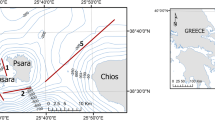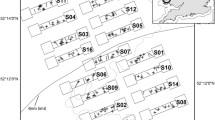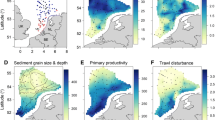Abstract
This paper examines spatial differences in the distribution of by-catch assemblages from the scallop [Pecten maximus (L.) and Aequipecten opercularis (L.)] fishing grounds in the North Irish Sea, during 1995. The sites examined have been exposed to differing known levels of fishing disturbance by scallop dredging, based on unusually high-resolution data extracted from fishermens' logbooks. Uni- and multi-variate techniques have been used on a production dataset (a value which incorporates both abundance and biomass figures), as well as abundance and biomass data individually. The original species list was reduced to higher taxonomic groupings in line with the theory that the latter is more appropriate for detecting anthropogenic change. Species diversity and richness, total number of species, and total number of individuals all decrease significantly with increasing fishing effort. Species dominance increases with effort. Total abundance, biomass and production, and the production of most of the major individual taxa investigated decrease significantly with increasing effort. Multivariate analysis reveals a significant relationship between fishing effort and by-catch assemblage structure. The taxa most responsible for the differences are the echinoids and cnidarians, but prosobranch molluscs and crustaceans also contribute to the differences. By-catch assemblage structure is more closely related to fishing effort than any other environmental parameter investigated, including depth and sediment type. We observed an approximately linear decrease in diversity with increasing fishing disturbance, and suggest this is primarily due to selective removal of sensitive species and, more importantly, habitat homogenisation. These results were interpreted in the light of ecological theories relating disturbance to community structure. The argument that invertebrate scavenger populations benefit from prolonged exposure to fishing disturbance was also examined, but no supporting evidence was found.
Similar content being viewed by others
Author information
Authors and Affiliations
Additional information
Received: 29 January 2000 / Accepted: 31 May 2000
Rights and permissions
About this article
Cite this article
Veale, L., Hill, A., Hawkins, S. et al. Effects of long-term physical disturbance by commercial scallop fishing on subtidal epifaunal assemblages and habitats. Marine Biology 137, 325–337 (2000). https://doi.org/10.1007/s002270000357
Issue Date:
DOI: https://doi.org/10.1007/s002270000357




